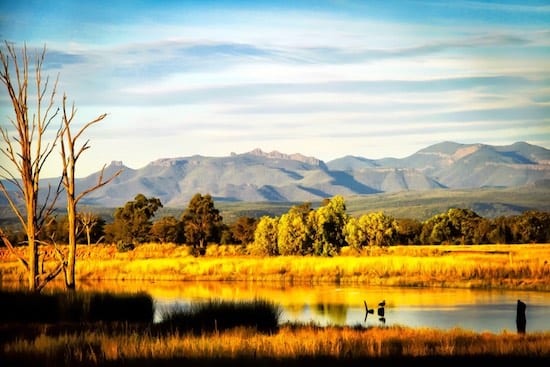Mining the New South Wales town of Narrabri for its solar and wind resources, instead of for its coal seam gas, would create more jobs, use a fraction of the land and prevent the removal of 35 billion litres of ground water, a new report has found.
The new report, based on modelling by the UTS Institute for Sustainable Futures, has found that Narrabri has “enormous potential” to contribute to Australia’s shift to renewable energy, with scope for the construction of between 1GW and 4.5GW of large-scale solar and wind.
The Shire of Narrabri, in NSW North West Slopes region, is currently embroiled in controversy over plans to develop a massive coal seam gas project proposed for the area by Santos.
The project, which would be made up of 850 wells and “hundreds” of kilometres of pipelines and roads spanning 950 square kilometres, attracted a record 23,007 public submissions, 98 per cent of which objected to the project, according to Santos.
Environmentalists argue that mining the area for coal seam gas risks further damage to the populations of already endangered species in the area, threatens the ground water of the Great Artesian Basin, and would create tens of thousands of tonnes of toxic salt as a byproduct.
And it is not only environmentalists who question the practice of unconventional gas mining in Australia.
A 2016 report by the Melbourne Energy Institute warned Australia could be underestimating its annual greenhouse gas emissions by an amount equivalent to the output of the nation’s entire transport sector, by failing to account for CSG leakages and fugitive emissions released during CSG “fracking.”
In the same year, Australian energy giant AGL announced it was quitting gas exploration and production – and dropping its controversial CSG projects in the Gloucestor Basin – to focus on the “evolution” of the energy industry.
And in neighbouring Victoria, the Labor Andrews government announced a permanent legislative ban on coal seam gas mining in the state, based on what it said was the best available evidence, and because the risks involved outweighed any potential benefits to the state.
For Narrabri, the ISF report hopes to show that there is a better energy, economic, and environmental alternative to coal seam gas for the area – which is, after all, part of the New England Renewable Energy Precinct, set up by the NSW Government in 2010 to attract new investment.
The report modelled to different scenarios: an Advanced Renewable Scenario, where the rest of Australia shifts to 100% renewables by 2030; and a Renewables Export Scenario, which sits within the state’s current clean energy policies.
In the Advanced Scenario, the ISF says Narrabri could host 3.8GW of solar and 600MW of wind using just 17 per cent of the land are required for the proposed Narrabri gas field.
Under this $6.5 billion scenario, 3,600 jobs would be created during the construction phase, and 2,680 ongoing jobs by 2030.
Under the Renewables Export Scenario, 622MW of solar would be built, and 175MW of wind, using just 4 per cent of the land are of the proposed gas field.
This $1 billion scenario – illustrated in the infographic below – would create 500 permanent local jobs, the report says, and allow for surplus energy to be exported to the national electricity market.
 “This report shows that Narrabri has a skilled, stable and sustainable future in renewable energy development,” it says.
“This report shows that Narrabri has a skilled, stable and sustainable future in renewable energy development,” it says.
“Renewable energy development outlined in this report can generate jobs and clean energy, without putting groundwater at risk or producing toxic waste products,” the report says.
“It will utilise only a tiny fraction of the land a ffected by the gasfield, and will avoid mobilising large volumes of methane – a potent greenhouse gas.
“This can coexist with the rural industries that already thrive in the region.”
But those hoping for renewables over CSG in Narrabri face a tough battle.
The project – Santos having released a formal reply to the public submissions – has moved into the next phase of the approvals process, before a revised target for construction starting in mid-to-late 2019 and production in 2021-22.
Santos says the CSG project, which is 30 per cent owned by major “gen-tailer” EnergyAustralia, is expected to supply around 200 terajoules a day of gas – enough to meet up to half of demand in NSW.
That amount of gas would certainly be welcomed by the federal government, which has repeatedly called for the states to open up their unconventional gas reserves for mining and production, and slammed Victoria’s ban on “fracking” as “unconscionable.”
The Coalition sees gas as vital to both the transition to renewable energy, and for putting downward pressure on power prices – an argument that was recently used by chair of Manufacturing Australia, James Fazzino, to call for more CSG mining in Australia.
As we noted at the time of Fazzino’s comments, this is a questionable line of argument for Australia, and ignores the fact that there is a cheaper, cleaner alternative.
“In 2018, there is a stark choice before the community and the New South Wales government,” the ISF report says.
“Will we choose to safeguard precious groundwater, farmland, clean air and the social fabric of Narrabri? Or, allow all of that to be put at risk for a sprawling polluting gasfield and limited jobs with a 25 year expiry date?”
Note: This story is a restored version of the original which was lost in circumstances as yet unexplained by our web host company. Apologies if earlier comments are missing.








